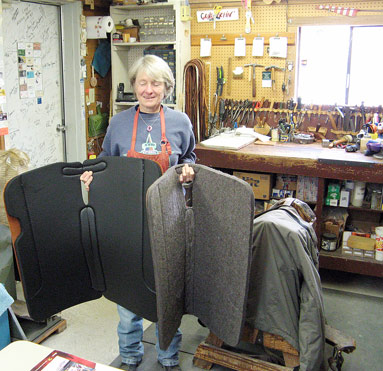A new saddle, pads and bridle cost approximately $1,000 to $1,500 or more in today’s market. So it is important to make it last as long as possible.
Unmaintained tack can fail at the worst times. You don’t want the cinch to snap while traveling at a fast lope or a stirrup to come loose while trying to calm a half-broke horse.
Try controlling a horse with a broken rein. These types of wrecks can happen when tack is not kept in good condition. Clean, oiled and properly-fitted tack results in better horse performance and more comfort and safety for the rider.

Proper storage is important
The Western Saddle Guide (http://www.western-guide.com/saddle-storage.html) says, “Proper saddle maintenance starts with how you care for your saddle when it’s not in use.
Store your saddle in a dry place out of the sun. Excessive moisture causes leather to stretch and mildew.
Too much heat and sun dry out the leather which can cause brittleness and cracking.
“Store your saddle on a saddle stand. A variety of commercial stands are available in wood or aluminum and handy people can build their own.
The stand should be tall enough so that the stirrups don’t touch the ground to avoid the fenders bending out of shape.
Top of the stand should be wide enough to give the support needed to keep the saddle from curling.
Make sure the skirts aren’t twisted and that all of the saddle strings and straps are hanging down.”
Dry saddle pads can either be stored under the saddle or on top with the bottom side up. Bridles should be put in a cloth bag and positioned on a nail in a manner to allow them to hang straight.
The Western Saddle Guide says, “While it’s best never to lay your saddle on the ground, there are times when it’s necessary.
In these situations, the best options are to either lay your saddle on its side with the fenders and stirrups lying smoothly or with the fork down on its nose.
You would not want to leave your saddle for very long in either of these positions as they can cause the leather to bend out of shape.
“Your saddle should always be covered during storage to keep off dust, critters, water and other undesirables.
There are many commercial saddle covers available but a sheet, blanket or even newspapers are good solutions for a tight budget. Don’t use plastic covers, including the commercial ones, as this material holds in moisture and can cause mildew.”
Clean and oil leather
“Proper maintenance of leather tack requires cleaning and oiling,” says Rusty Glover, co-owner of San Saba Equine Supply, San Saba, Texas.
“Water does not hurt leather and it needs to be used with a soft detergent such as saddle soap or a liquid dishwashing soap. After the leather is clean, let it completely dry.
“Washing leather removes oil and conditioner – so you have to put them back,” continues Glover. “Dilute neatsfoot oil half and half with a conditioner such as Lexol or Fiebing’s 4-Way.
Oil a saddle and other leather tack by applying two or three coats to one side until it soaks through to the other side. Tack should be cleaned and oiled once a year and more often if it is heavily used.”
Skeeter Sprinkles, who makes and repairs saddles in Manor, Texas, prefers to use vegetable oils on saddles and leather tack.
He has found that they wash out of your pants easier and penetrate leather better than some of the other recommended oils.
Because of the better penetration, Sprinkles recommends light to moderate coats. He agrees with Glover that leather should never be oiled until they are completely dry.
Clean saddle blankets
“Dirt is best removed from heavy saddle pads at a car wash,” says J.T. Grumbles, the second partner in San Saba Equine Supply.
“Since car washes use a heavy detergent, the pads need to be rewashed with a liquid dishwashing soap, rinsed and allowed to dry. Saddle girths can be cleaned in the same manner.”
“A car wash or pressure washer can be used to clean fabric pads such as felt, fleece or Navajo,” states Sprinkles.
“The new closed-cell foam pads can be cleaned with a water hose and applying a mild solution of bleach helps control mildew. Before using soap to clean saddle pads, make sure they won’t be used on a horse that is allergic to detergents.”
Although saddle pads need to be replaced periodically because of wear, properly maintained leather tack will last indefinitely. ![]()







